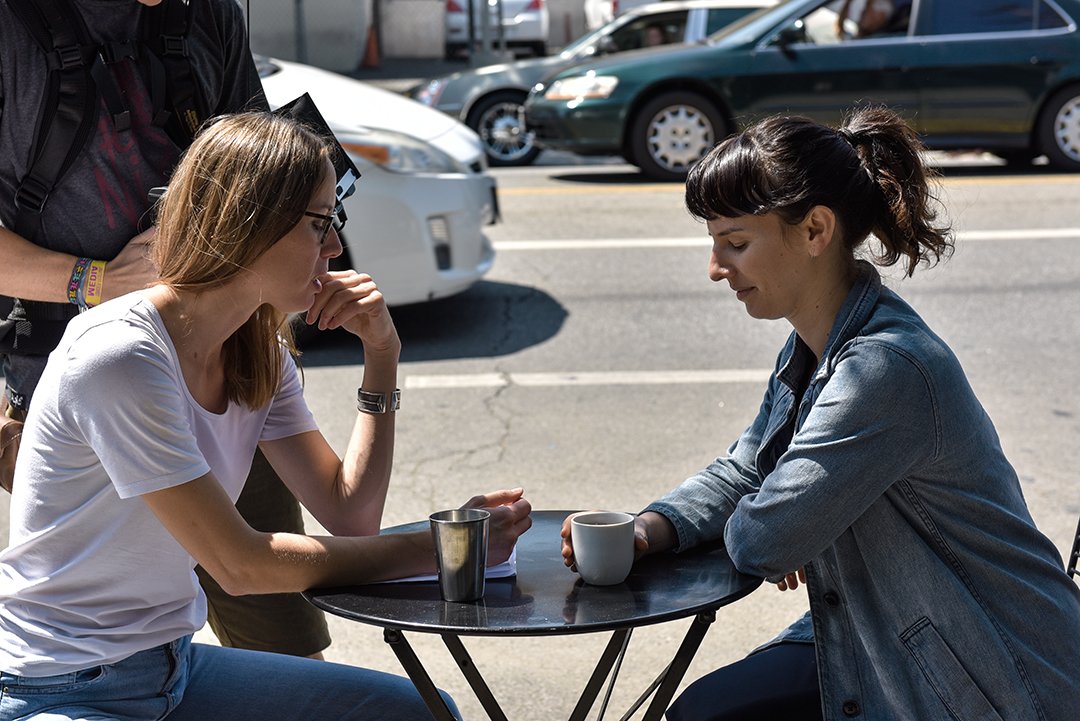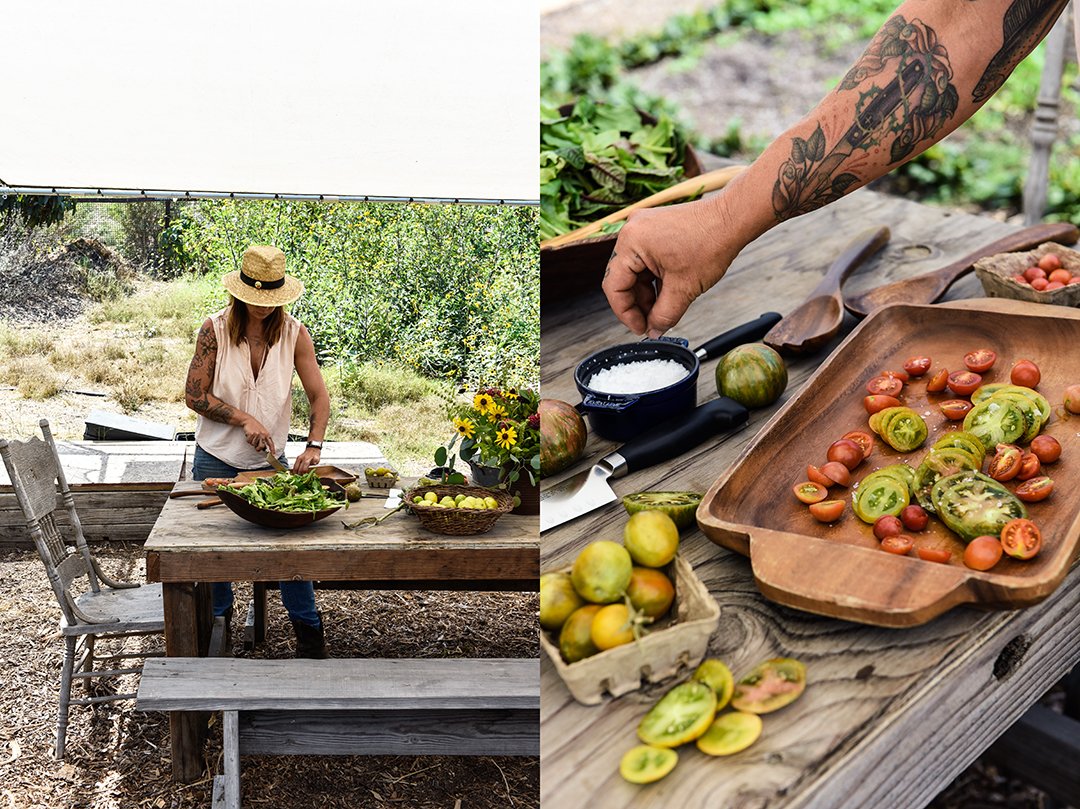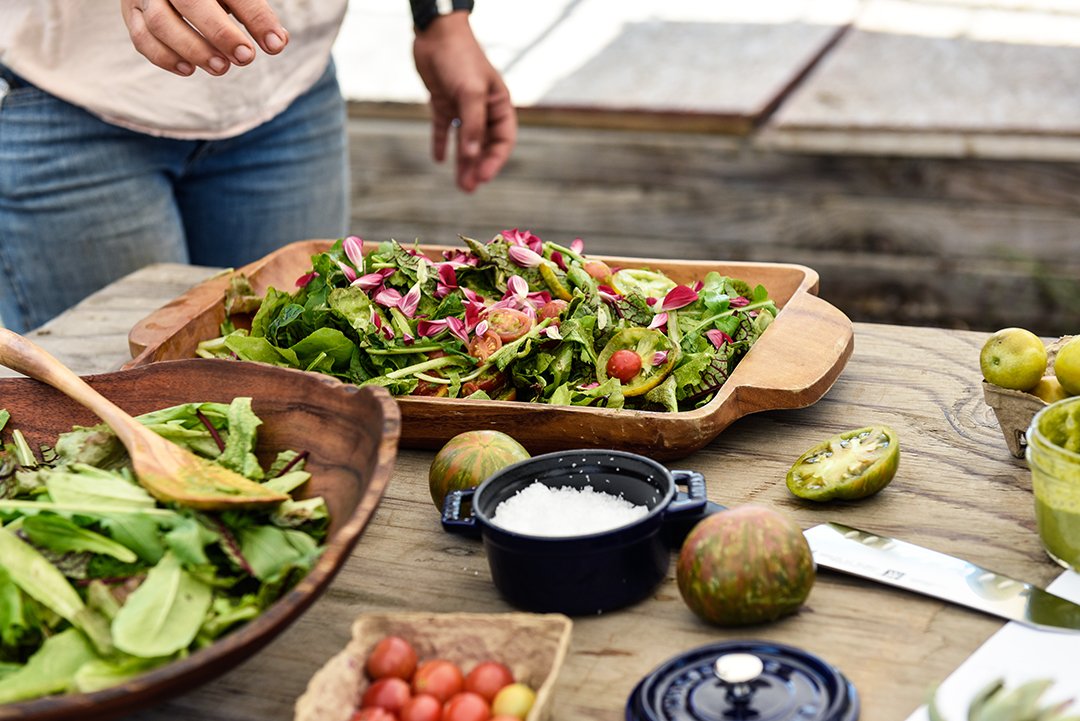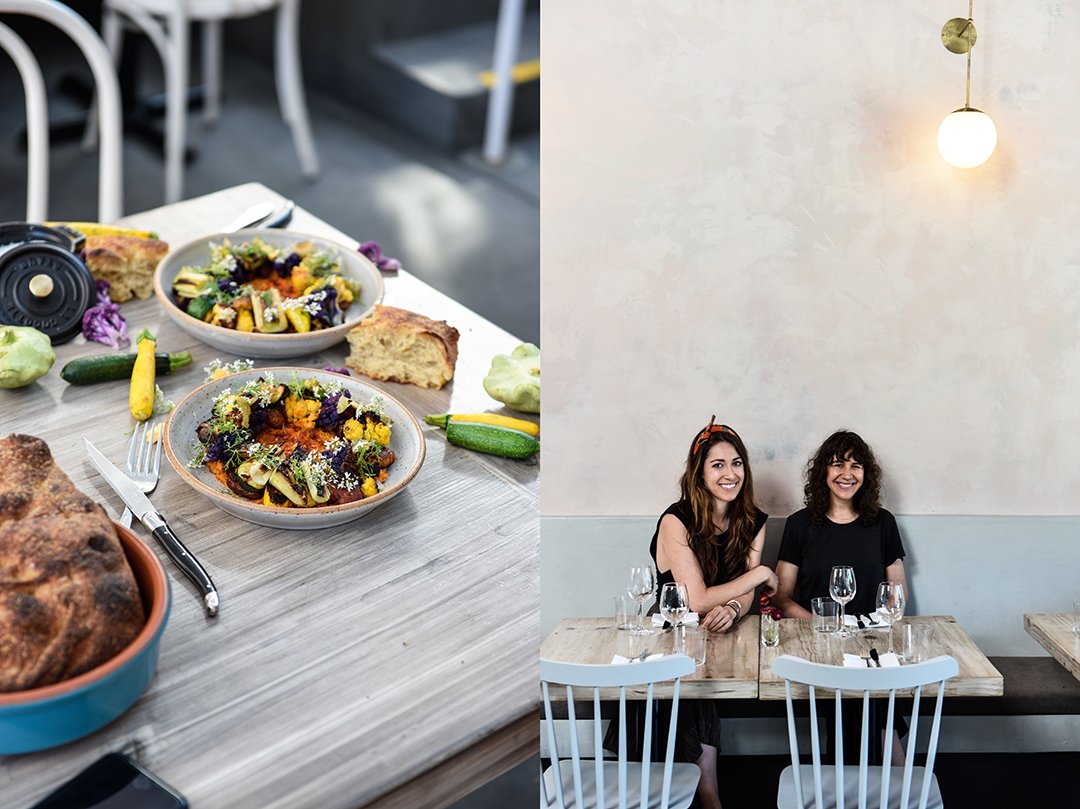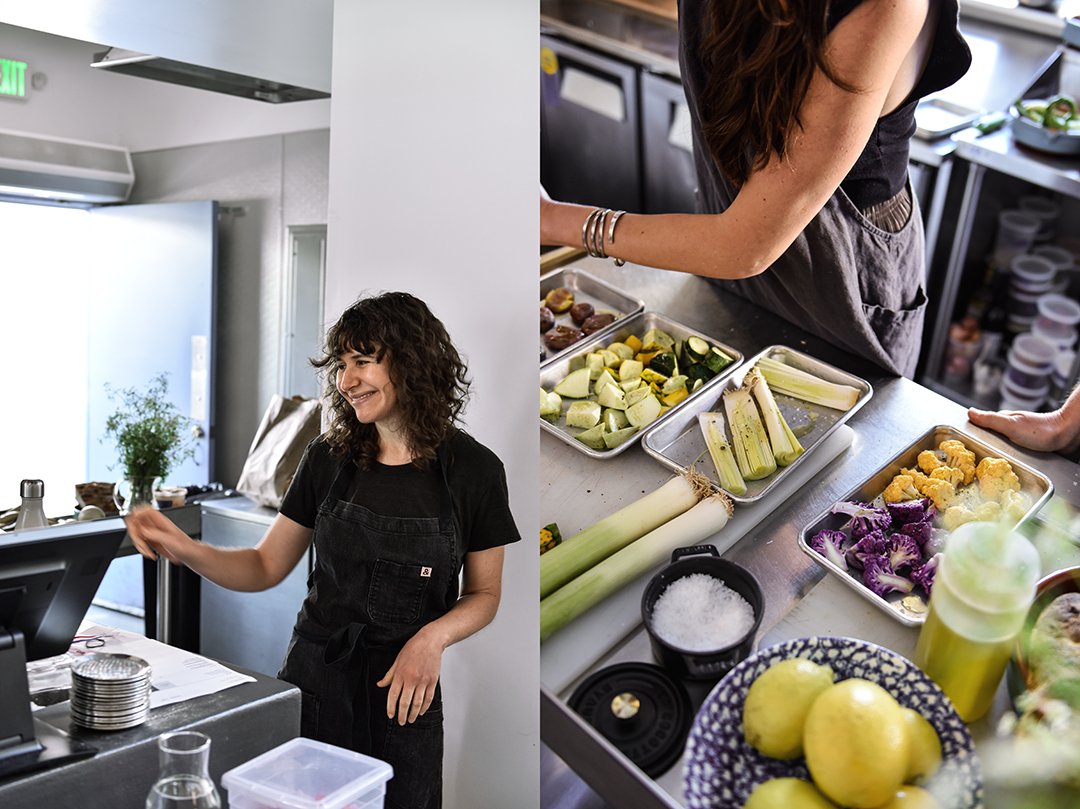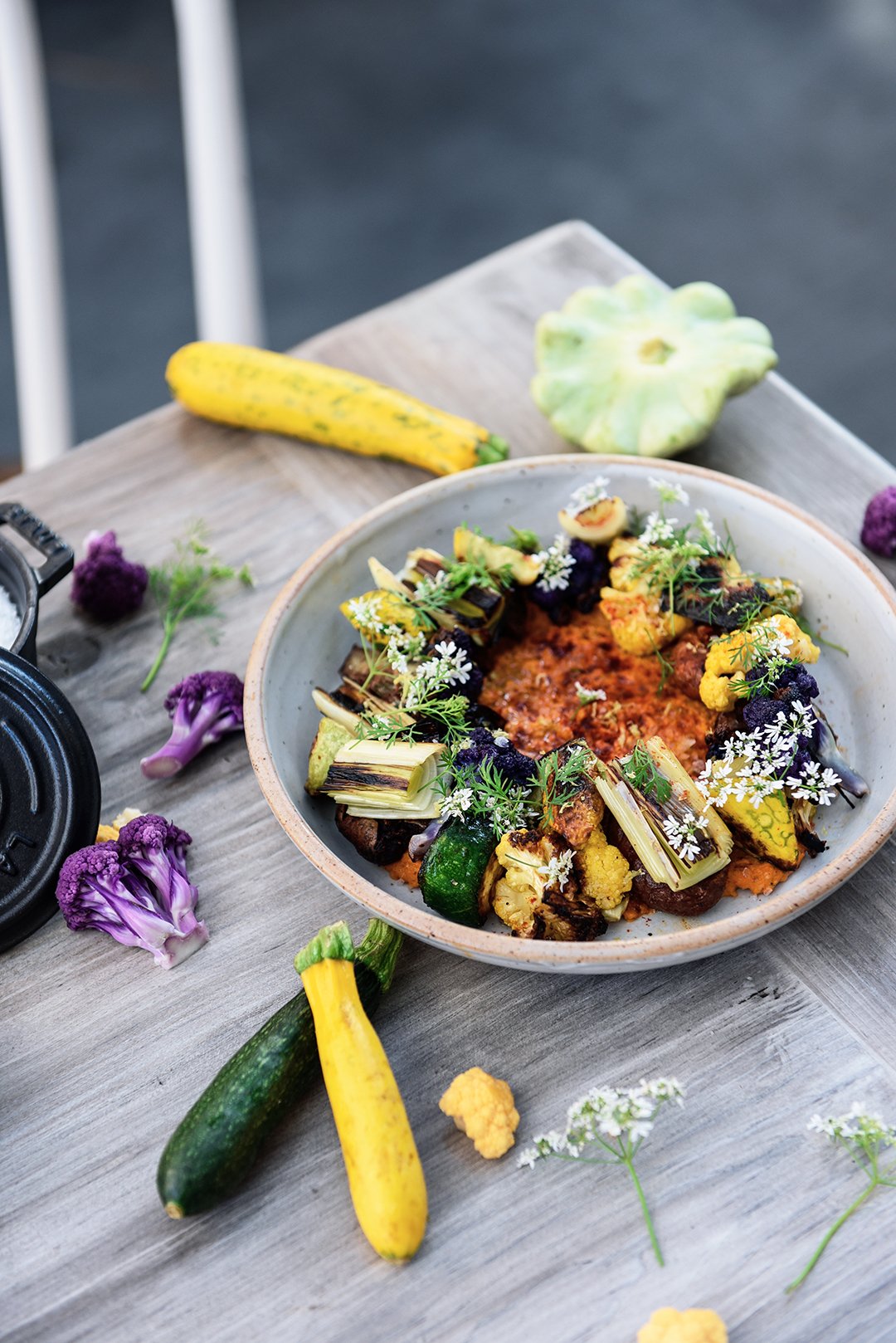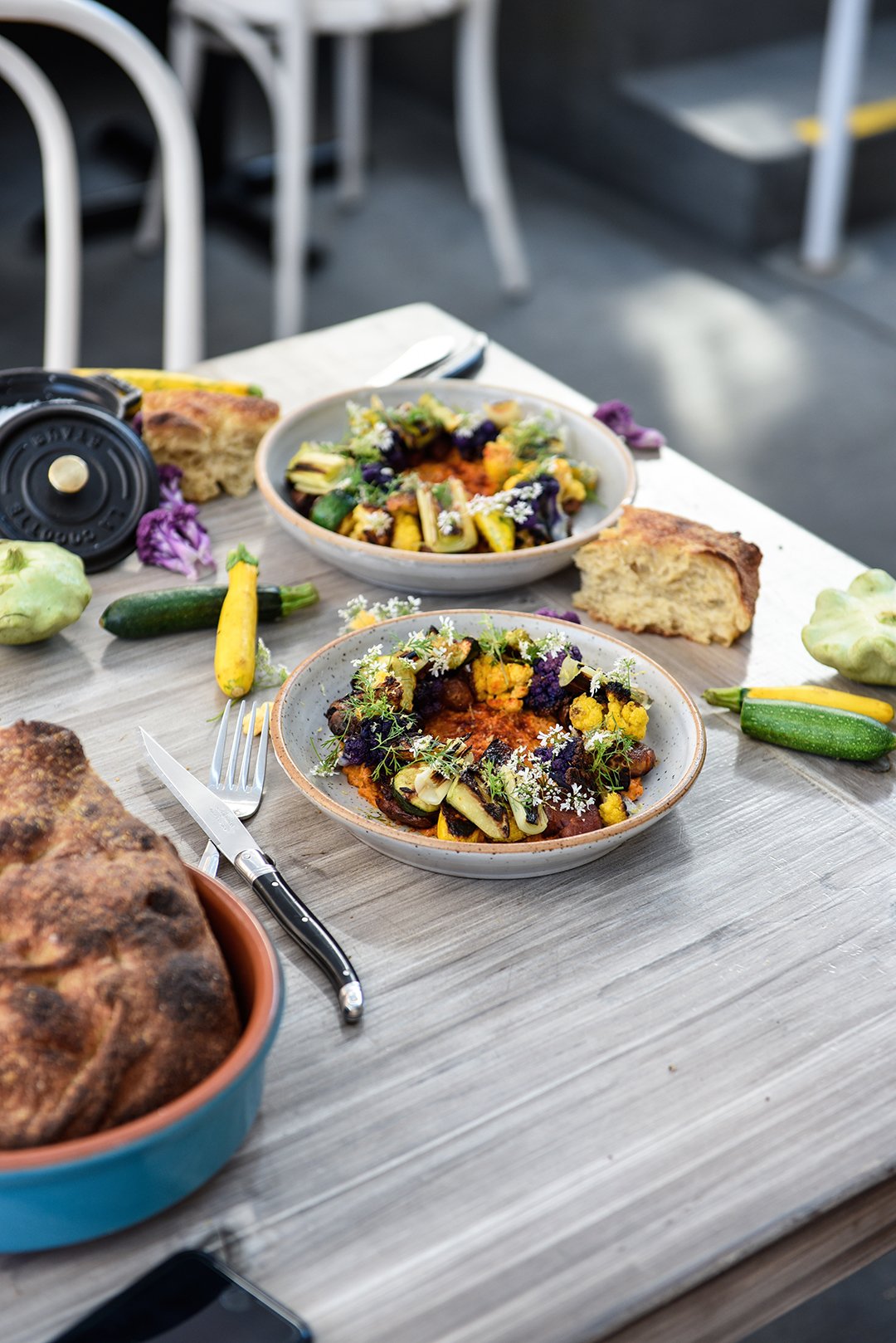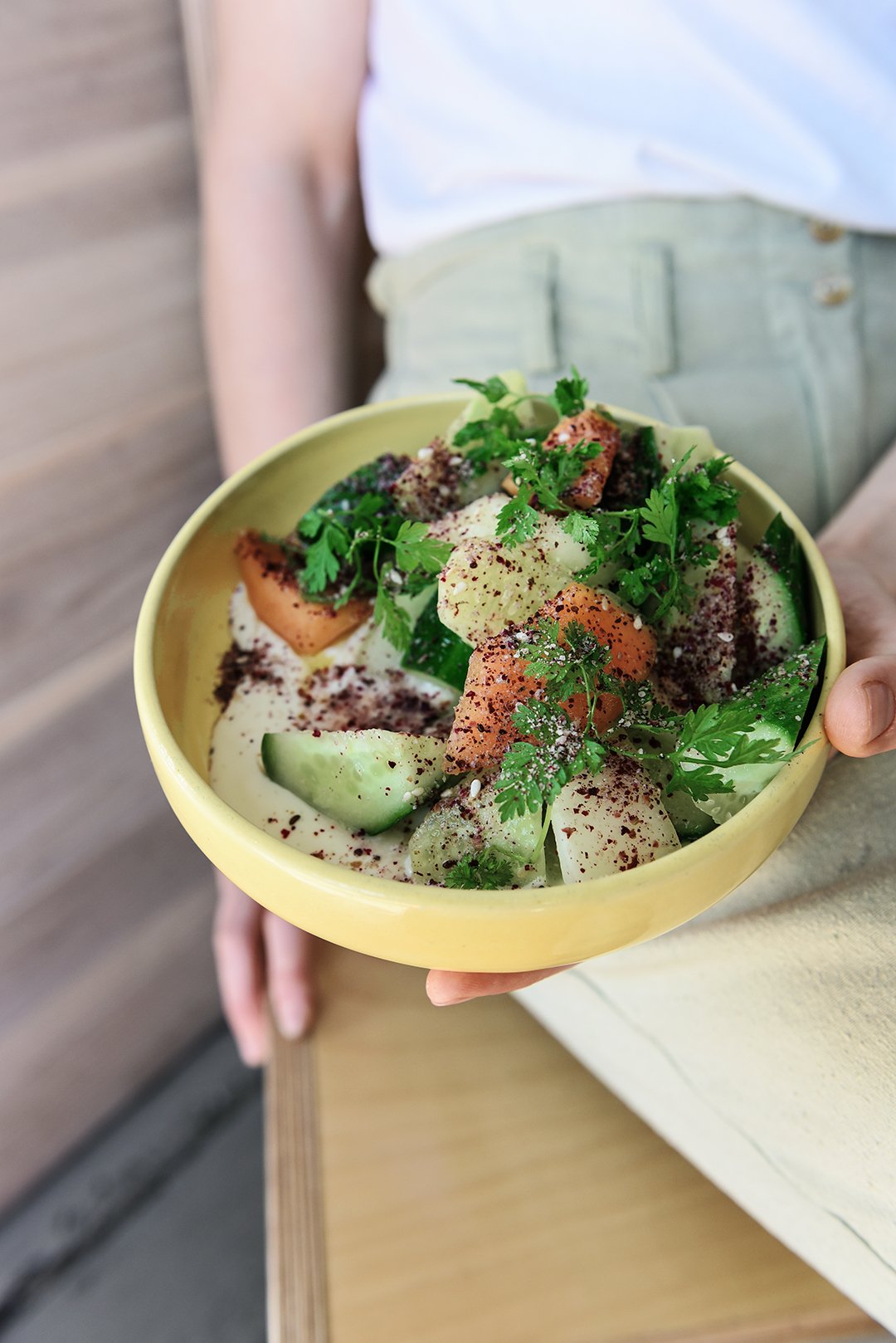Meet In Your Kitchen | Jessica Koslow's Sqirl in LA & the Magic of Sorrel Pesto Rice
It's captivating to watch a craftswoman concentrating on her material, a carpenter choosing the right piece of wood, a tailor feeling the fabrics, or a chef taking about a new recipe and picking the right ingredients. Jessica Koslow is a craftswoman, but she's equally an artist gifted with a huge sense for freedom and creativity and this shines through every single one of her creations. She's also a scientist who critically re-thinks all the single components of a dish until the final result is complete, until the textures and flavors feel aligned, until it looks deliciously tempting. This woman is so much, which makes her one of the leading figures of a new powerful movement of female chefs in California, but also in the rest of the world.
Sqirl is located just around the corner from Vermont Avenue that leads straight to Griffith Park, the restaurant is almost unspectacular, pleasantly unpretentious and casual, but the dishes that come out of the kitchen can easily compete with Michelin starred restaurants. The open kitchen works smoothly, peacefully, every chef seems to deeply enjoy the part they have in the Sqirl universe, it's a bit like friends cooking, just more precise. Like the Sorrel Pesto Rice, inspired by Pierre Troisgros, the father of the nouvelle cuisine movement, that blew my mind: Kokuho rose brown rice, sorrel pesto, preserved meyer lemon, lacto-fermented hot sauce, watermelon radish, French sheep feta, and a perfectly poached egg spreading its shiny liquid yolk all over this vibrant composition. And the Sqirl Chicken Salad with Marin Sun chicken, bok choy, dehydrated citrus and root vegetables, grated carrots, and black garlic vinaigrette balances crunch and tenderness, sweetness and bitterness, it's a dish that excites and satisfies.
Jessica comes across as very relaxed, she laughs a lot, but when you ask her a question she pauses and takes her time to think, to answer with the same precision you can find in her dishes, in the same way that she designed her restaurant, and how she put her first cookbook together, Everything I Want to Eat: Sqirl and the New California Cooking. There is a vision that only she can see that seems to guide her in the right direction. She used to be a competitive figure skater which explains her discipline and dedication, and when she stopped at 19, she channeled her obsession into something new: food.
From then on it was all about cooking, eating, and tasting. She was fascinated by the moment when you put the first bite into your mouth and you're overwhelmed. That's the experience she wants to create at her restaurant and she knows that she only has this first second to reach and convince her guests' taste buds. She and her team are gifted with outstanding produce, which she honors in her creations and that she receives from farmers who are friends and part of her community. This is the foundation of her work: "Raw produce defines a season, it's the passing of times and in California, thankfully, it's such a delicious marker of time. Our produce is an exciting time stamp and a building block from there." The Sqirl world is about dishes that feel familiar and unfamiliar at the same time, they create comfort and inquisitiveness, it's about different layers and textures, using the raw natural produce, but also playing with it, fermenting, pickling, or dehydrating it. As exciting as it is to eat this woman's food, it's a pure pleasure listing to her words.
Sqirl is a breakfast and lunch spot only, but in 2018 Jessica will open a dinner place for all her begging, hungry fans, called Tel - keep your eyes and ears open!
In the next months, I’ll share many new Meet In Your Kitchen features with you that took me to California, Italy, France, and Japan. Thanks to Zwilling for sponsoring these features for our culinary trip around the world!
Jessica Koslow's Sorrel Pesto Rice
Serves 6
3 cups (600 g) medium-grain brown rice, preferably Kokuho Rose
Fine sea salt
½ cup plus 2 teaspoons (130 ml) extra-virgin olive oil
1 cup (25 g) lightly packed kale leaves (stems removed)
2 cups (50 g) lightly packed chopped sorrel leaves
3 tablespoons fresh lemon juice
2 tablespoons chopped fresh dill, plus more for serving
1 Preserved Meyer Lemon, flesh removed, peel finely chopped
2-4 small watermelon radishes, very thinly sliced
¼ cup (60 ml) Fermented Jalapeño Hot Sauce
¾ cup (85 g) crumbled sheep’s-milk feta
6 poached eggs
Fleur de sel
Freshly ground black pepper
Boil the rice in plenty of salted water until it’s tender, 30 to 45 minutes. Drain and let cool.
Meanwhile, make the sorrel pesto: In a blender or food processor, combine ½ cup (120 ml) of the oil, kale, sorrel, and 1 tablespoon of the lemon juice. Blend until smooth, stopping and scraping down the sides as needed. Season with salt to taste.
In a large bowl, toss the rice with the dill, preserved lemon peel, 1 tablespoon of the lemon juice, and the pesto. Taste and add a bit more salt, if needed.
In a small bowl, toss the radish with the remaining 1 tablespoon lemon juice, the remaining 2 teaspoons oil, and a pinch of salt. Set aside to marinate for a few minutes, until the radish is pliable and tender.
To serve, divide the rice among six bowls. Spoon a line of hot sauce across the rice. Arrange a little clump of feta on one side and a rosette of radish slices on the other side. Set a poached egg in the middle of each bowl and season it with fleur de sel and black pepper. Garnish with a tiny sprig or two of dill.
Watch my interview with Jessica in LA in September 2017:
Thank you, Jessica!
Jessica Koslow
Meet In Your Kitchen | Urban Farming and a Garden Salad at LA's Farm Lot 59
A 1-hour drive, leaving the skyline and the buzz of Downtown LA behind, and you're in Long Beach, still LA county, yet a totally different scene. As we left California Avenue in the south and drove our bulky van down a dusty road for a new Meet In Your Kitchen feature together with Zwilling, the inspiring urban farmer Sasha Kanno welcomed us with a big smile in front of the gate of her green oasis, Farm Lot 59.
Sasha is a woman with a strong vision and principles, she believes in honest food, available not only for herself, but also for the community that she lives in. She took over the land surrounded by urban industrial buildings in 2010 and turned it into a non-profit organic farm, practicing biodynamics and following the Waldorf School philosophy. The farmer who's fascinated by rare and heirloom varieties and who gets many of her seeds from a 100-year old seed company in Honolulu, is famous and loved by locals and chefs for her outstanding lettuce and herb mixtures. All year round, she puts an exciting seasonal bouquet together, of arugula, lemony blood sorrel, giant red-leaf mustard lettuce, basil (with a rough surface), huacatay (black mint), cilantro, fennel, tarragon, thyme, chocolate mint, and many more. Her edible flowers, such as pensi, dahlia, dianthus, calendula, lavender chamomile flowers, are a feast for the eye and an explosion of flavors for the palate.
However, as much as she loves to share the produce from her garden with other passionate lovers of natural, healthy fruits and vegetables, Sasha felt that there was more for her to do. She started an educational program of cooking and gardening classes, she wanted to bring the basics back to the table of our children: her tomatoes, beans, eggplants, pumpkins, squash (I learnt that you can even eat its leaves cooked like a vegetable), peppers, snake melon, and artichokes. She wanted them to smell again and listen to the sounds of the woods and fields, and taste pure unprocessed food. She saw city kids who were totally overwhelmed by this experience, being confronted by nature, even stressed some of them. Some of the most common fruits and vegetables had never been in the hands of these children before. It's an essential experience, if not a right to have access to food in its original form. Sasha takes responsibility to teach them about our fragile ecosystem, so that future generations adjust the way that we deal with ourselves, our food, and our environment.
The doors of Farm Lot 59 are open almost every day and it's worth visiting this green paradise framed by apple, stone fruit, and guava trees. You can buy the handpicked produce and humanely sourced meats, dairy products, and eggs from friends and other farmers at the farm's market stand at the street, the Farmstand 59. And then you go home and prepare the beautiful salad that Sasha made for us in her outdoor farm kitchen: a colorful tomato salad with the farmer's delicious basil vinaigrette featuring the pure taste and beauty of this sweet fruit and fragrant herb!
In the next months, I’ll share many new Meet In Your Kitchen features with you that took me to California, Italy, France, and Japan. Thanks to Zwilling for sponsoring these features for our culinary trip around the world!
Sasha Kanno's Tomato Salad with Basil Vinaigrette
Serves 4
For the dressing
1 cup (240ml) olive oil
2 tablespoons red wine vinegar
1 red onion, roughly chopped
2 cups fresh Tuscan basil
1 clove garlic
½ teaspoon haberno salt (haberno peppers mixed with sea salt)
For the salad
8-12 green, red and yellow ripe tomatoes (of various sizes), sliced
2 large handfuls mixed young lettuce greens
1 small handful edible flower petals
For the dressing, purée the ingredients in a blender until smooth and season to taste with salt. Add more oil if the dressing is too thick.
Spread the lettuce greens and tomatoes in a large bowl, sprinkle with the dressing and flower petals and serve immediately.
Watch my interview with Alana in LA in September 2017:
Thank you, Sasha!
Meet In Your Kitchen | Heather and Emily celebrate LA's vegetables at Botanica
One of the kitchens that I visited on my trip to LA - the first stop of my new adventure together with Zwilling - was at Botanica, a stunningly beautiful restaurant founded by the wonderful Heather Sperling and Emily Fiffer. Both women had been working in the food industry as editors on the East coast for more than a decade, but they were hungry for more. They chose LA to bring a project to life, giving it all their love, passion, and honest determination. An old run-down liquor store in Silverlake looked less than promising when they first saw it, but Heather and Emily knew from the start that this would be the right place to give their vision a home. They gutted it and after a year of sweat and work you can't even imagine how this gorgeous bright and airy space looked before the renovations. A tall wall touched up in a soft Tuscan pink holds the old wooden beams above the restaurant's rustic wooden tables and the little market where you can buy the products and produce used in Botanica's kitchen.
The two ladies also started an online magazine, a collection of the recipes used at their restaurant to complete their customers hungry needs: you can eat a dish at Botanica, fall in love with it so much that you want to cook it at home, buy the ingredients right away, grab the recipe from the magazine, and go straight to your own kitchen and cook it again.
Sitting at this restaurant feels a bit like being in Heather and Emily's home and this was an important aspect for them when they first started thinking about their restaurant baby. The design, the menu they put together, the way they work together with their employees, this all shows a philosophy of working and living together in a community. They have strong connections with the other restaurants in their neighborhood, many of which are also run by women, and together they put the spotlight back onto LA's culinary scene (like "Kismet" that I wrote about last week and Jessica Koslow's "Sqirl", which will be featured here on the blog in 2 weeks). They not only share the same work ethics, but also their farmers and suppliers.
And they all have one more thing in common, all these restaurants celebrate vegetables. Heather and Emily manage to turn a potato, cauliflower, squash, or carrot into a vibrant feast. They shift the traditional focus from meat and seafood centric dishes to roots, cabbages, and legumes. Botanica is not a vegetarian restaurant, but ribs, steaks, or fillets aren't the star of the meal anymore, they can be a part of a greater composition, add flavor, be a luxurious treat of outstanding quality, but they aren't essential anymore. And the two women's recipes are so fantastic that you won't even miss it, you just indulge in a dish like their seared vegetables with romesco (recipe below), which is so rich, balanced, and exciting that you don't ever think of anything but tasty vegetables. And apart from this more than satisfying pleasure for the taste buds, you can be sure that you just enjoyed food that is good for your body, locally sourced in a strong community that works with and not against nature and our environment.
In the next months, I’ll share many new Meet In Your Kitchen features with you that took me to California, Italy, France, and Japan. Thanks to Zwilling for sponsoring these features for our culinary trip around the world!
Heather Sperling and Emily Fiffer's Seared Vegetables with Romesco
Serves 4
For the romesco
4 red bell peppers
1 jalapeño, seeds removed
2 medium cloves garlic
¼ cup (60ml) olive oil
1 tablespoon sherry vinegar
1 small lemon, zest and juice
2 teaspoons Spanish smoked paprika
1 cup (140g) toasted almonds
1 large handful fresh cilantro leaves (about ¼ cup chopped)
Sea salt
For the vegetables
20 tiny potatoes (preferably purple), boiled in salted water until just tender, drained and cooled
Olive oil
Sea salt
Black pepper
Spanish smoked paprika
Broccolini, summer squash, romanesco, Brussels sprouts or cauliflower (or a mix)
3 leeks, white and light green part only, cut in half lengthwise
For the topping
About ½ lemon, zest and juice
1 small handful fresh cilantro flowers (or cilantro leaves)
Preheat the oven to 450°F (230°C).
To make the romesco: Roast the bell peppers until blistered and fully soft. Transfer to a large bowl and let them cool for a few minutes. Remove and discard the seeds and stems, collect the thick juices that run off the peppers. Peel the skin and set aside.
In a food processor, combine the roasted peppers and their skin, the jalapeño, garlic, olive oil, vinegar, lemon zest and juice, smoked paprika, almonds, cilantro, and a splash of the liquid from the peppers. Blend until fully incorporated, but not fully uniform; some texture is ideal here. Add more sherry vinegar, salt, olive oil, and cilantro to taste.
For the vegetables: Lightly crush each potato with the side of a knife. Heat a splash of olive oil in a pan over medium heat and sauté the potatoes on one side until just starting to crisp, then flip and crisp up the other side. Remove from oil and season well with salt, pepper, and a sprinkle of smoked paprika.
While the potatoes are crisping, prepare the remaining vegetables: Cut the vegetables into bite size pieces (except the leeks) and toss with olive oil, salt and pepper, then grill or sear until al dente, with nice char in spots. In a large pan, cook the leeks, cut-side down, until they get a touch of caramelized char, then flip and cook for a few minutes on the other side, until soft through. Cut in two-inch lengths, season, and set aside.
Mound the romesco in the center of a large plate and arrange the potatoes, leeks and vegetables in a ring around the purée. Garnish with a good drizzle of olive oil, a squeeze of lemon juice, lemon zest, a sprinkle of salt, and the cilantro flowers and serve immediately.
Watch my interview with Heather and Emily in LA in September 2017:
"I think that for many women in the industry, they are very aware that this is a moment in time when they can be actively involved in changing the culture of the restaurant world."
Thank you, Heather and Emily!
Meet In Your Kitchen | Kismet LA's Persian Cucumbers, Melon & Rosewater Labneh
White brushed walls, pale wood, and strong geometric lines turn Kismet into a minimalist spot of casual elegance right on LA's sunny Hollywood Boulevard. Sitting on the wooden bench at the wide window, the fleshy leaves of a tall banyan tree playing with the light, I felt immediately captured by the restaurant's laid-back vibe and exciting Middle Eastern and Mediterranean-style menu.
Sarah Hymanson and her partner Sara Kramer created a beautiful place to enjoy breakfast, lunch, or dinner with a group of friends - following their philosophy that food tastes best when you share it. Kismet is a neighborhood hub where you can fill your table with plates full of colorful vegetable focused delicacies and indulge in the pleasures of wonderful treats such as Little Gem Lettuce with Plums, Sprouted Lentils and Tarragon, Freekeh Polenta with Lamb, Green Chili, Greens and Poached Egg, or the wonderful Persian Cucumbers with Melon, Rosewater Labneh and Parsley Seed Za'atar – this recipe is a feast for the taste buds thankfully shared with us by the two chefs. You just dig in and feel happy, inspired by new flavor combinations focusing on taste and freshness. Or celebrate some precious time just for yourself and a book, have a coffee, and nibble on a Scone with Lemon Cream or Brioche Toast with Date Butter.
"LA is an exciting place to be right now, there's a lot of young creative energy", Sarah says. She doesn't hide that she loves the East coast, she's from Chicago and worked in New York for years, moving west wasn't an obvious step for her. In 2015, she met NY native Sara Kramer at Glasserie in New York, Kramer was the opening chef at the acclaimed restaurant and won Eater's NYC Chef of the Year award for her celebrated way of cooking. Yet the two strong willed chefs and highly creative minds who developed the vision of opening their own place, had to find out that it wasn't in the East but West, in California, where their first "baby" would open its doors. An organic falafel shop at the lively Grand Central Market in Downtown LA called Madcapra was their testing ground. It became a huge success and so Kismet came next.
Rooted in California through the produce that the Kismet chefs get from their beloved farmers and friends who are such an important part of their community of chefs – "their produce is what makes our food" - yet their style of cooking is very much based on their experiences in the kitchen and their upbringing. Thanks to the similar climate, they can use a lot of fruits and vegetables that are prominent in Middle Eastern cooking, such as pomegranate, dates, olives, and fresh herbs. This is the kind of food that both of them loved all their life, what they grew up with – Sara's mother is Israeli – it's the food that fascinates both of them and constantly feeds their inspiration.
LA has always offered a great platform and an excitable open-minded audience to female chefs, like Nancy Silverton, Suzanne Goin, Marie Sue Milliken, and Susan Feniger to name just a few. There's a history of inspiring women in this city and also in California in general who try alternative ways of producing food, cooking, but also working together. Over the past few years, there have been changes in restaurants all over the US that touch the roots of this industry. Work ethics change, the tone in the kitchen that was very male for decades, changes. "The women today try to challenge these norms by treating people as people. It's not an easy process, but it's a responsibility to the industry and the people working in this industry." Sarah and her partner introduced a 20% service charge on top to improve payments and also even out the gap between front and back of house at their restaurant. It's not easy, but it's an important part of the place that they want to create, where it's about good food, but also about a healthy community, in and outside Kismet.
In the next months, I’ll share many new Meet In Your Kitchen features with you that took me to California, Italy, France, and Japan. Thanks to Zwilling for sponsoring these features for our culinary trip around the world!
Persian Cucumbers with Melon, Rosewater Labneh and Parsley Seed Za'atar
By Kimset / Sarah Hymanson and Sara Kramer
Serves 6
For the Za'atar
2 tablespoons untoasted sesame seed, ground
1 tablespoon whole toasted sesame seeds
¾ cup (about 12g) dried rose petals, broken up
1 ½ teaspoons sumac
1 teaspoon parsley seeds, ground
¼ teaspoon salt
For the rosewater labneh
2 cups (470g) labneh
1 teaspoon salt
Zest of 2 lemons
2 cloves garlic, grated on a microplane
2 teaspoons honey
¼-1 tablespoon rose water, to taste
Black pepper, finely ground, to taste
For the salad
9-12 Persian cucumbers, rinsed, shaved lengthwise on a mandoline
1 cup (about 160g) melon, cut into oblique pieces
Juice of 2 lemons
Olive oil
Salt, to taste
Fresh chervil, leaves only
For the Za'atar, in a small bowl, combine the untoasted and toasted sesame seeds, rose petals, sumac, parsley seeds, and salt. You can keep the Za'atar in an airtight container for up to 1 week.
For the labneh, in a large bowl, combine the labneh, salt, lemon zest, garlic, honey, and ¼ tablespoon of the rose water and season to taste with pepper and additional rosewater. You can prepare the rose water labneh in advance and keep it in the fridge for 1 day.
For the salad, mix together the cucumbers, melon, lemon juice, olive oil, and a pinch of salt. Toss to coat and set aside.
Divide the rose water labneh between bowls, arrange the cucumbers and melon on top, and sprinkle each portion with about 1 teaspoon of the Za'atar and a little chervil. Serve immediately.
Watch my interview with Sarah in LA in September 2017:
Thank you, Sarah!











